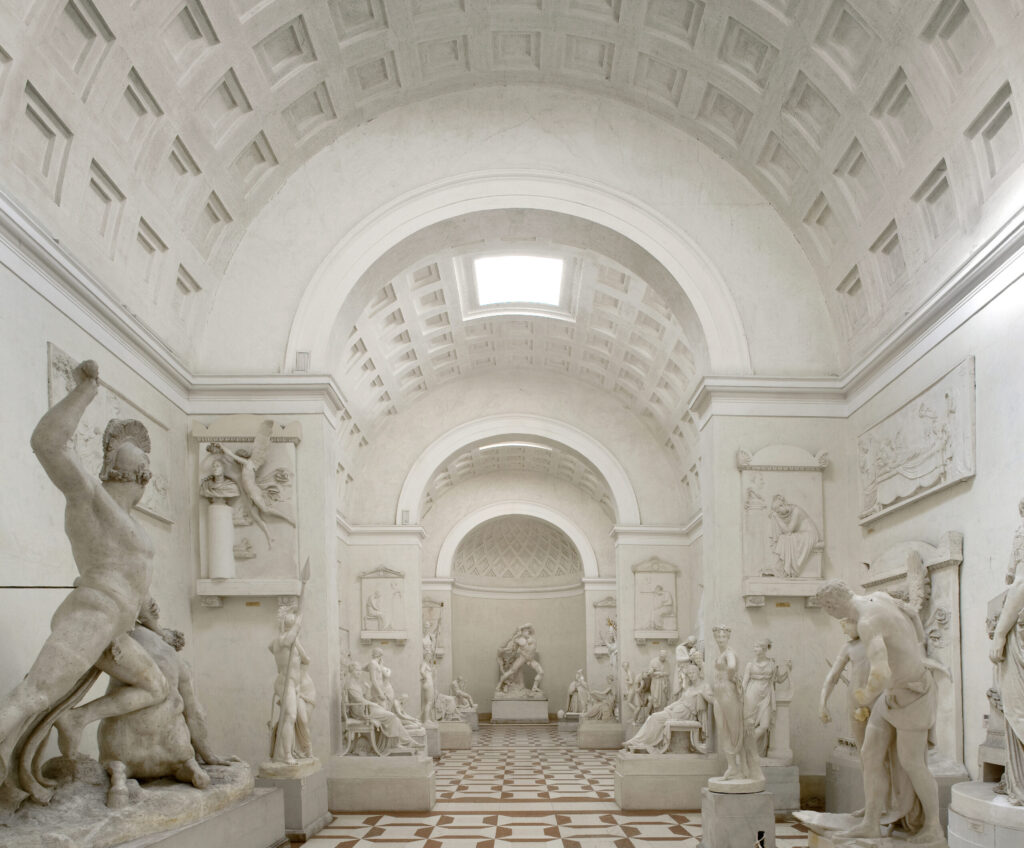Antonio Canova, the great neoclassical sculptor, was born in Possagno: the most important testimonies of his art (sculptures, reliefs, sketches, paintings …) can be found today in the birthplace and in the nearby Gypsotheca where Canova’s brother, Giovanni Battista Sartori, has wanted to transfer, since 1829, all the plaster models that were in the Roman studio at the death of the artist.
The Possagno Museum, one of the first museums in Veneto, provides the complete image of the art and life of Antonio Canova: in addition to the plaster casts (which are the original statues, of which the marbles scattered around the world are replicas), the paintings in oil and tempera, drawings, memories, clothes, work tools, books …
All this, within precious architectures that provide the most valid context for appreciating Canova’s grandiose artistic production: from the eighteenth-century house, built according to the expertise of local master stonecutters and stonecutters, to the nineteenth-century Gypsotheca by Francesco Lazzari; from the twentieth-century enlargements by Carlo Scarpa and Luciano Gemin to the grandiose Temple, designed by Canova himself as a town church, a few meters from his house.
Therefore, it is not only a collection of statues: the Antonio Canova Museum in Possagno is the “Canovian complex”, made up of museums, archives, libraries, study centers, collaborations …
And it is a lively and innovative place for the dissemination of Canova knowledge thanks to workshops, reinterpretations, guides, itineraries, virtual tours, publications, etc. able to educate and transmit culture.
The Antonio Canova Museum in Possagno collects the great historical and artistic heritage of the greatest exponent of Neoclassicism.
It is divided into:
- Gypsotheca, where the original plaster models of the works of Antonio Canova are kept;
- Birthplace, where the artist’s paintings, drawings and clothes are located;
- Garden, Brolo and Park that complete with the Library and the Historical Archive a unique and original space in which the illustrious sculptor was born and found inspiration.
The treasure of art and beauty preserved in Possagno are an indispensable point of reference for getting to know the artist and appreciating all together the masterpieces created, models from which the marbles commissioned and now widespread in the largest museums in the world were made.
THE GYPSOTHECA OF CANOVA
The word “gypsotheca” derives from the Greek and means collection of gypsum, that of Possagno, in fact, is the largest monographic Gypsotheca in Europe.
Bishop Giovanni Battista Sartori, half-brother of Antonio Canova, wanted to erect a building that could worthily house all the works present in the Roman Studio in Via delle Colonnette: from 1829 they were thus transferred from Rome, embarked in Civitavecchia and, after weeks of transport, from Marghera, arrived on wagons as far as Possagno.
Trying to reproduce the exhibition of the works as they were inside the sculptor’s atelier, the building was designed by the architect Francesco Lazzari of Venice. The works began in 1834 under the direction of Giovanno Zardo and were completed in 1836, while the setting up, after the loving restorations of the sculptor Pasino Tonin, first conservator of the Gypsotheca, was completed in 1844.
In 1917, during the First World War, a grenade hit the Gypsotheca: some plaster casts were completely destroyed, dozens were damaged. The grandiose restoration work by the conservators Stefano and Siro Serafin, father and son, allowed the Gypsotheca to be reborn and reopened to visitors in 1922.
At the outbreak of the Second World War, to prevent new bombings, the Gypsotheca was partly emptied, the statues were transferred and deposited inside the Temple of Possagno, where they remained until 1946. The current layout is the result of absolute respect of the museological spirit of Giovanni Battista Sartori, of the variations resulting from the damage of the two world wars and of the contribution of the architect. Carlo Scarpa in 1957.
THE EXTENSION OF CARLO SCARPA
In 1957, some Canovian works by Possagno found a more adequate arrangement thanks to a new building, built by the Venetian architect Carlo Scarpa (Venice, 1906 – Sendai, 1978).
The aim of the project was to enhance Canova’s heritage still not exhibited and lying in the deposits, and, above all, to prepare an appropriate exhibition for the terracotta sketches. Scarpa managed to scenically arrange those absolute masterpieces of art, distributing them on shiny staggered levels, placed within an architectural envelope that allows light to filter from above.
Today the Scarpa extension is the only museum space entirely completed by the architect and alongside the plaster models there are all the clay and terracotta sketches, an absolute expression of Canova’s genius.
Timetables and prices
From Tuesday to Saturday, from 9:30 to 18:00
Dome

